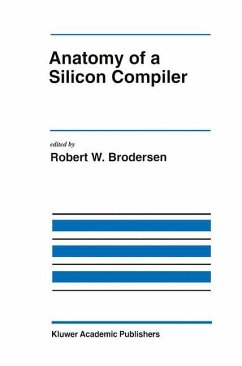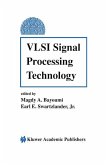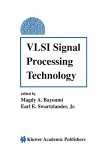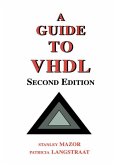- Gebundenes Buch
- Merkliste
- Auf die Merkliste
- Bewerten Bewerten
- Teilen
- Produkt teilen
- Produkterinnerung
- Produkterinnerung
A silicon compiler is a software system which can automatically generate an integrated circuit from a user's specification. Anatomy of a Silicon Compiler examines one such compiler in detail, covering the basic framework and design entry, the actual algorithms and libraries which are used, the approach to verification and testing, behavioral synthesis tools and several applications which demonstrate the system's capabilities.
Andere Kunden interessierten sich auch für
![VLSI Signal Processing Technology VLSI Signal Processing Technology]() BayoumiVLSI Signal Processing Technology83,99 €
BayoumiVLSI Signal Processing Technology83,99 €![VLSI Signal Processing Technology VLSI Signal Processing Technology]() VLSI Signal Processing Technology74,99 €
VLSI Signal Processing Technology74,99 €![A Guide to VHDL A Guide to VHDL]() Stanley MazorA Guide to VHDL83,99 €
Stanley MazorA Guide to VHDL83,99 €![Digital Phase Lock Loops Digital Phase Lock Loops]() Saleh R. Al-ArajiDigital Phase Lock Loops117,99 €
Saleh R. Al-ArajiDigital Phase Lock Loops117,99 €![Acoustical and Environmental Robustness in Automatic Speech Recognition Acoustical and Environmental Robustness in Automatic Speech Recognition]() A. AceroAcoustical and Environmental Robustness in Automatic Speech Recognition125,99 €
A. AceroAcoustical and Environmental Robustness in Automatic Speech Recognition125,99 €![Digital Phase Lock Loops Digital Phase Lock Loops]() Saleh R. Al-ArajiDigital Phase Lock Loops191,99 €
Saleh R. Al-ArajiDigital Phase Lock Loops191,99 €![Essentials of Electronic Testing for Digital, Memory and Mixed-Signal VLSI Circuits Essentials of Electronic Testing for Digital, Memory and Mixed-Signal VLSI Circuits]() M. BushnellEssentials of Electronic Testing for Digital, Memory and Mixed-Signal VLSI Circuits95,99 €
M. BushnellEssentials of Electronic Testing for Digital, Memory and Mixed-Signal VLSI Circuits95,99 €-
-
-
A silicon compiler is a software system which can automatically generate an integrated circuit from a user's specification.
Anatomy of a Silicon Compiler examines one such compiler in detail, covering the basic framework and design entry, the actual algorithms and libraries which are used, the approach to verification and testing, behavioral synthesis tools and several applications which demonstrate the system's capabilities.
Hinweis: Dieser Artikel kann nur an eine deutsche Lieferadresse ausgeliefert werden.
Anatomy of a Silicon Compiler examines one such compiler in detail, covering the basic framework and design entry, the actual algorithms and libraries which are used, the approach to verification and testing, behavioral synthesis tools and several applications which demonstrate the system's capabilities.
Hinweis: Dieser Artikel kann nur an eine deutsche Lieferadresse ausgeliefert werden.
Produktdetails
- Produktdetails
- The Springer International Series in Engineering and Computer Science 181
- Verlag: Springer / Springer US / Springer, Berlin
- Artikelnr. des Verlages: 978-0-7923-9249-1
- 1992.
- Seitenzahl: 384
- Erscheinungstermin: 30. Juni 1992
- Englisch
- Abmessung: 241mm x 160mm x 26mm
- Gewicht: 717g
- ISBN-13: 9780792392491
- ISBN-10: 0792392493
- Artikelnr.: 21697775
- Herstellerkennzeichnung
- Books on Demand GmbH
- In de Tarpen 42
- 22848 Norderstedt
- info@bod.de
- 040 53433511
- The Springer International Series in Engineering and Computer Science 181
- Verlag: Springer / Springer US / Springer, Berlin
- Artikelnr. des Verlages: 978-0-7923-9249-1
- 1992.
- Seitenzahl: 384
- Erscheinungstermin: 30. Juni 1992
- Englisch
- Abmessung: 241mm x 160mm x 26mm
- Gewicht: 717g
- ISBN-13: 9780792392491
- ISBN-10: 0792392493
- Artikelnr.: 21697775
- Herstellerkennzeichnung
- Books on Demand GmbH
- In de Tarpen 42
- 22848 Norderstedt
- info@bod.de
- 040 53433511
1 Introduction and History.- 1.1. What is Lager.- 1.2. Users vs. Developers.- 1.3. History.- 1.4. Assembly vs. Behavioral synthesis.- 1.5. Book Organization.- I Framework and Design Entry.- 2 The OCT Data Manager.- 2.1. Basic Structure.- 2.2. Policy Versus Mechanism.- 2.3. The OCT Objects.- 2.4. The OCT Procedural Interface.- 2.5. OCT Physical Policy.- 2.6. OCT Symbolic Policy.- 2.7. Summary.- 3 Lager OCT Policy and the SDL Language.- 3.1. Lager Policies.- 3.2. The Structure_Master View and the SDL Language.- 3.3. The Structure_Instance View.- 3.4. The Physical View.- 3.5. Summary.- 4 Schematic Entry.- 4.1. Schematic Tool Interface.- 4.2. Design Examples.- 4.3. Summary.- 5 Design Management.- 5.1. Parameterization and Library Support.- 5.2. The Design Flow Strategy.- 5.3. Controlling the Design Flow.- 5.4. The Design Management Strategy.- 5.5. Summary.- 6 Design Post-Processing.- 6.1. Capabilities.- 6.2. The Post Processing Tools.- 6.3. Runtime Operation.- 6.4. Summary.- II Silicon Assembly.- 7 Hierarchical Tiling.- 8 Standard Cell Design.- 9 Interactive Floorplanning.- 10 Datapath Generation.- 11 Pad Routing.- III Verification and Testing.- 12 Design Verification.- 13 Behavior and Switch Level Simulation.- 14 Chip and Board Testing.- IV Behavioral Synthesis.- 15 DSP Specification Using the Silage Language.- 16 Synthesis of Datapath Architectures.- 17 From C to Silicon.- 18 An FIR Filter Generator.- V Applications.- 19 The PUMA Processor.- 20 Radon Transform Using the PPPE.- 21 Speech Recognition.- 22 Conclusions and Future Work.- Appendix a Design Example.- A.1. Running Dmoct to Generate a Design.- A.2. Design Post-Processing with Dmpost.- Appendix B Training and Distribution.- B.1. Training.- B.2. Lager Distribution.
1 Introduction and History.- 1.1. What is Lager.- 1.2. Users vs. Developers.- 1.3. History.- 1.4. Assembly vs. Behavioral synthesis.- 1.5. Book Organization.- I Framework and Design Entry.- 2 The OCT Data Manager.- 2.1. Basic Structure.- 2.2. Policy Versus Mechanism.- 2.3. The OCT Objects.- 2.4. The OCT Procedural Interface.- 2.5. OCT Physical Policy.- 2.6. OCT Symbolic Policy.- 2.7. Summary.- 3 Lager OCT Policy and the SDL Language.- 3.1. Lager Policies.- 3.2. The Structure_Master View and the SDL Language.- 3.3. The Structure_Instance View.- 3.4. The Physical View.- 3.5. Summary.- 4 Schematic Entry.- 4.1. Schematic Tool Interface.- 4.2. Design Examples.- 4.3. Summary.- 5 Design Management.- 5.1. Parameterization and Library Support.- 5.2. The Design Flow Strategy.- 5.3. Controlling the Design Flow.- 5.4. The Design Management Strategy.- 5.5. Summary.- 6 Design Post-Processing.- 6.1. Capabilities.- 6.2. The Post Processing Tools.- 6.3. Runtime Operation.- 6.4. Summary.- II Silicon Assembly.- 7 Hierarchical Tiling.- 8 Standard Cell Design.- 9 Interactive Floorplanning.- 10 Datapath Generation.- 11 Pad Routing.- III Verification and Testing.- 12 Design Verification.- 13 Behavior and Switch Level Simulation.- 14 Chip and Board Testing.- IV Behavioral Synthesis.- 15 DSP Specification Using the Silage Language.- 16 Synthesis of Datapath Architectures.- 17 From C to Silicon.- 18 An FIR Filter Generator.- V Applications.- 19 The PUMA Processor.- 20 Radon Transform Using the PPPE.- 21 Speech Recognition.- 22 Conclusions and Future Work.- Appendix a Design Example.- A.1. Running Dmoct to Generate a Design.- A.2. Design Post-Processing with Dmpost.- Appendix B Training and Distribution.- B.1. Training.- B.2. Lager Distribution.








